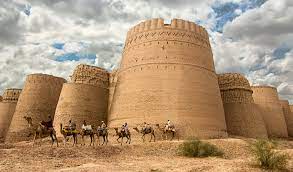Bahawalpur and its History
Bahawalpur: A Historical Journey Through Time
Introduction
Bahawalpur is a city and former princely state located in the Punjab province of Pakistan. Steeped in rich history, it has witnessed the rise and fall of numerous dynasties, leaving behind a legacy of architectural marvels and cultural heritage. This comprehensive exploration delves into the history of Bahawalpur, spanning from ancient times to the present day, covering its evolution from a princely state to a part of modern Pakistan.
I. Prehistoric and Ancient Periods
The history of Bahawalpur dates back to prehistoric times when the region was inhabited by various ancient civilizations. Archaeological excavations have revealed evidence of human settlement in the area, dating as far back as the Stone Age.
During the ancient period, Bahawalpur was a part of the fertile Indus Valley Civilization, one of the world’s earliest urban societies that thrived around the Indus River. The Indus Valley Civilization, with its advanced urban planning, trade networks, and script, significantly impacted the region’s cultural and social development.
II. Bahawalpur during the Vedic and Achaemenid Eras
With the decline of the Indus Valley Civilization, the Vedic period marked the arrival of Indo-Aryans in the region. They established their settlements and introduced Vedic traditions, rituals, and religious practices.
Subsequently, the Achaemenid Empire, under the reign of Emperor Darius I, expanded its territories to include parts of present-day Pakistan, including Bahawalpur. The region became an integral part of the Persian Empire, and the influence of Persian culture and governance shaped its early history.
III. The Arrival of Islam and Early Muslim Rule
During the 7th century CE, the Arab armies led by Muhammad bin Qasim invaded the Indian subcontinent, bringing Islam to the region. The spread of Islam led to the establishment of Muslim rule in various parts of present-day Pakistan, including Bahawalpur.
In the following centuries, the region came under the rule of different Muslim dynasties, such as the Ghaznavids, Ghorids, and Delhi Sultanate. The influences of Islamic art, architecture, and culture became apparent, leaving lasting imprints on the landscape of Bahawalpur.
IV. The Rise of Bahawalpur as a Princely State
In the 18th century, the region of Bahawalpur gained autonomy and emerged as a princely state under the rule of Nawab Bahawal Khan I. The state was founded around 1702, and the ruling family, the Abbasi dynasty, claimed ancestry from the Abbasid Caliphs of Baghdad.
Over the years, Bahawalpur expanded its territory through successful military campaigns and strategic alliances. The Nawabs of Bahawalpur enjoyed relative independence, paying nominal tributes to the Mughal Empire and later to the British East India Company.
V. British Influence and the Decline of the Princely States
The British East India Company gradually expanded its control over the Indian subcontinent during the 18th and 19th centuries. The princely states, including Bahawalpur, faced political and economic challenges as British suzerainty extended across the region.
In 1833, Bahawalpur signed a treaty with the British, becoming a British protectorate and agreeing to abide by British suzerainty in exchange for maintaining internal autonomy. The British influence led to modernization efforts, infrastructure development, and educational reforms in Bahawalpur.
VI. Bahawalpur: A Center of Art and Culture
During the 19th and early 20th centuries, Bahawalpur experienced a cultural renaissance. The ruling Nawabs were patrons of art, literature, and architecture. The city witnessed the construction of magnificent palaces, mosques, and other structures that showcased a blend of Islamic and local architectural styles.
Notable examples of this era’s architecture include the Noor Mahal, built by Nawab Sadiq Muhammad Khan IV, and the Darbar Mahal, an impressive palace complex. These architectural gems continue to be major tourist attractions, representing the opulence and cultural heritage of the region.
VII. Bahawalpur and the Struggle for Independence
As the Indian independence movement gained momentum in the early 20th century, Bahawalpur played a role in supporting the broader nationalist cause. The All India Muslim League, under the leadership of Muhammad Ali Jinnah, advocated for the creation of a separate Muslim state.
During the partition of British India in 1947, Bahawalpur became a part of the newly formed country, Pakistan. It joined as a princely state but later integrated into the One Unit scheme of West Pakistan in 1955.
VIII. Modern Bahawalpur: Cultural Heritage and Development
After Pakistan’s independence, Bahawalpur continued to grow as an important cultural and economic center in the Punjab province. The city’s educational institutions, including Islamia University Bahawalpur, have contributed to the region’s intellectual and academic progress.
Bahawalpur remains famous for its unique art forms, including pottery, embroidery, and camel-skin craft. The annual “Cholistan Desert Rally,” an off-road motor racing event, has gained popularity and attracts participants and spectators from across Pakistan and beyond.
IX. Bahawalpur: Present and Future Prospects
In recent years, Bahawalpur has witnessed significant infrastructural development, including the construction of a modern airport, road networks, and industrial zones. The city’s strategic location and growing economic activities have made it a vital player in Pakistan’s progress.
Conclusion
Bahawalpur’s journey through history showcases a fusion of ancient civilizations, Islamic heritage, and princely splendor. From the Indus Valley Civilization to its prominence as a princely state and its place in modern Pakistan, the city has retained its unique identity while embracing progress.
Today, Bahawalpur stands as a testament to its historical legacy, preserving architectural marvels and cultural traditions while looking toward a promising future as a dynamic city contributing to the nation’s growth and development. The story of Bahawalpur is an intriguing narrative that reflects the resilience and evolution of a region that continues to be an integral part of Pakistan’s vibrant tapestry.







